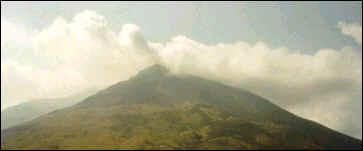![]()

When volcanoes are formed, a large chamber, known as a magma chamber, which is a reservoir
from which the volcanic materials erupt.
The magma in this reservoir is filled
with gas. It is pressured by the solid rock around it. The high pressure causes the magma
to bust or melt a conduit (channel) into a part of the rock, which is usually weakened.
The magma moves up through this channel to the surface, and the gas in the magma is
released. The gas and magma burst an opening called the central vent. Then the magma and
other volcanic material then spills out of this vent. They gather around the vent, forming
a volcano. When the eruption has stopped, a crater is created at the top of the volcano.
The vent is right at the bottom of the crater.
Not all magma from later eruptions reaches the surface through the vent under the crater
because some of the hot lava may break througn the wall and divide into smaller channels.
The magma will then escape through a vent formed in the side of the volcano. Otherwise, it
remains below the surface.